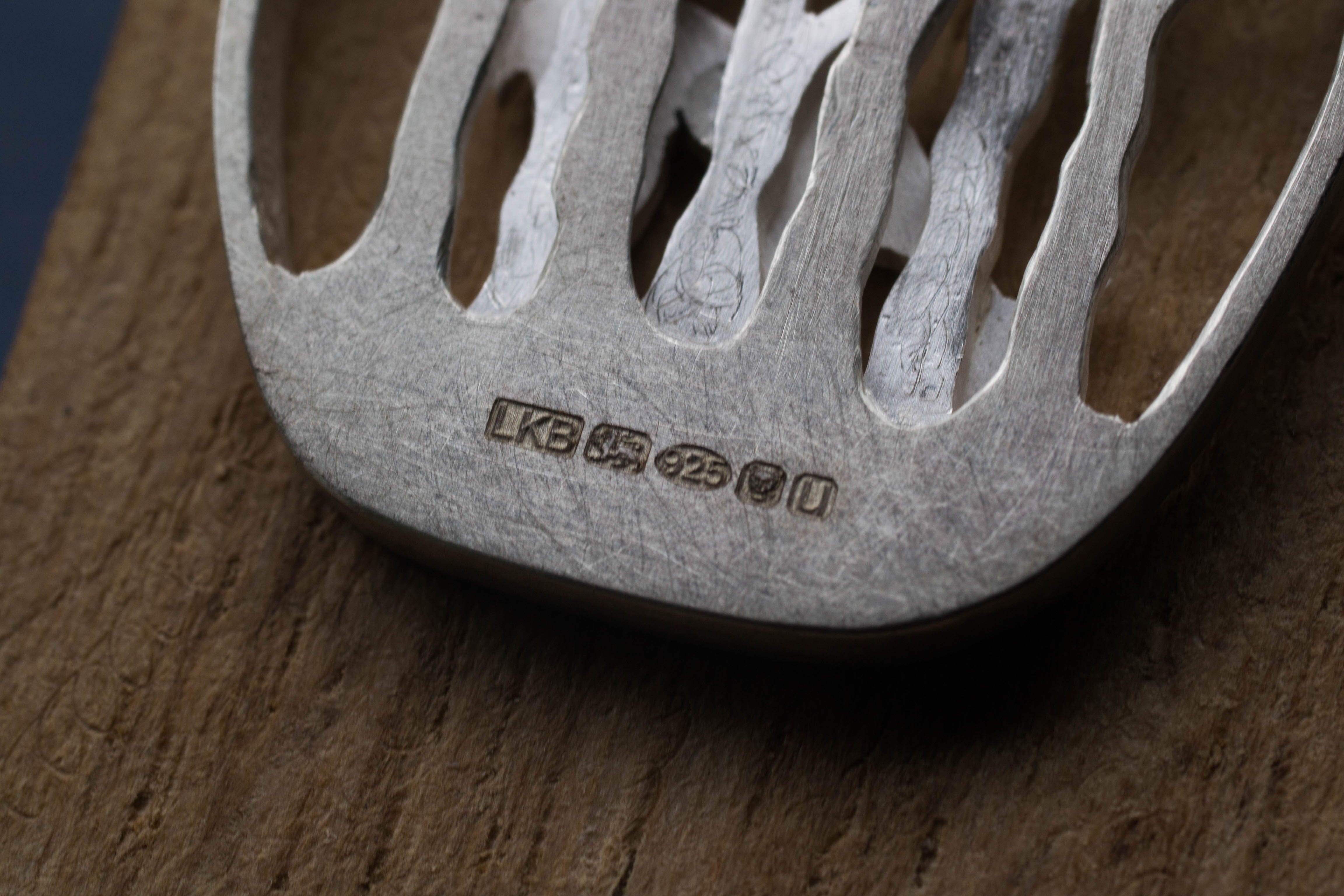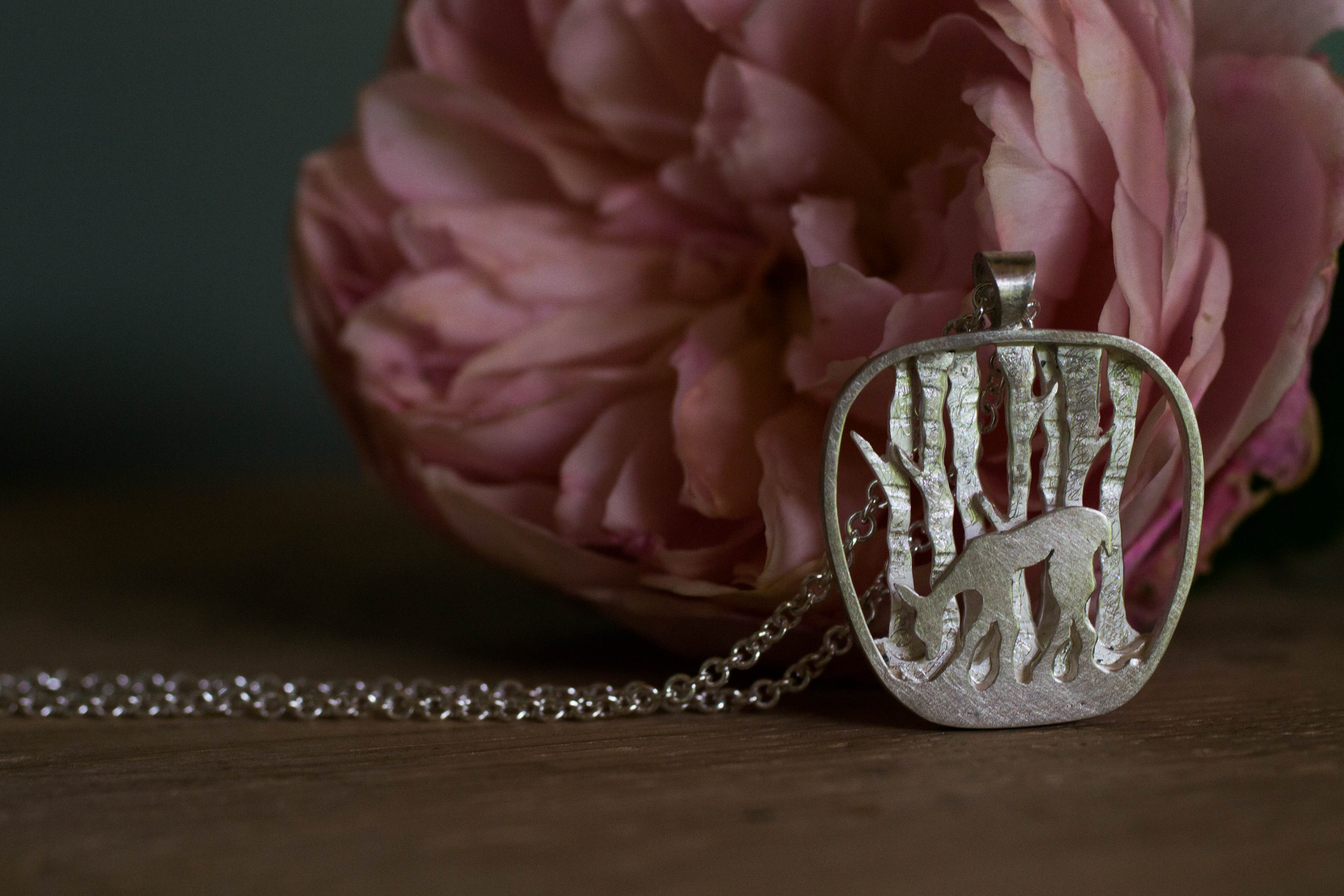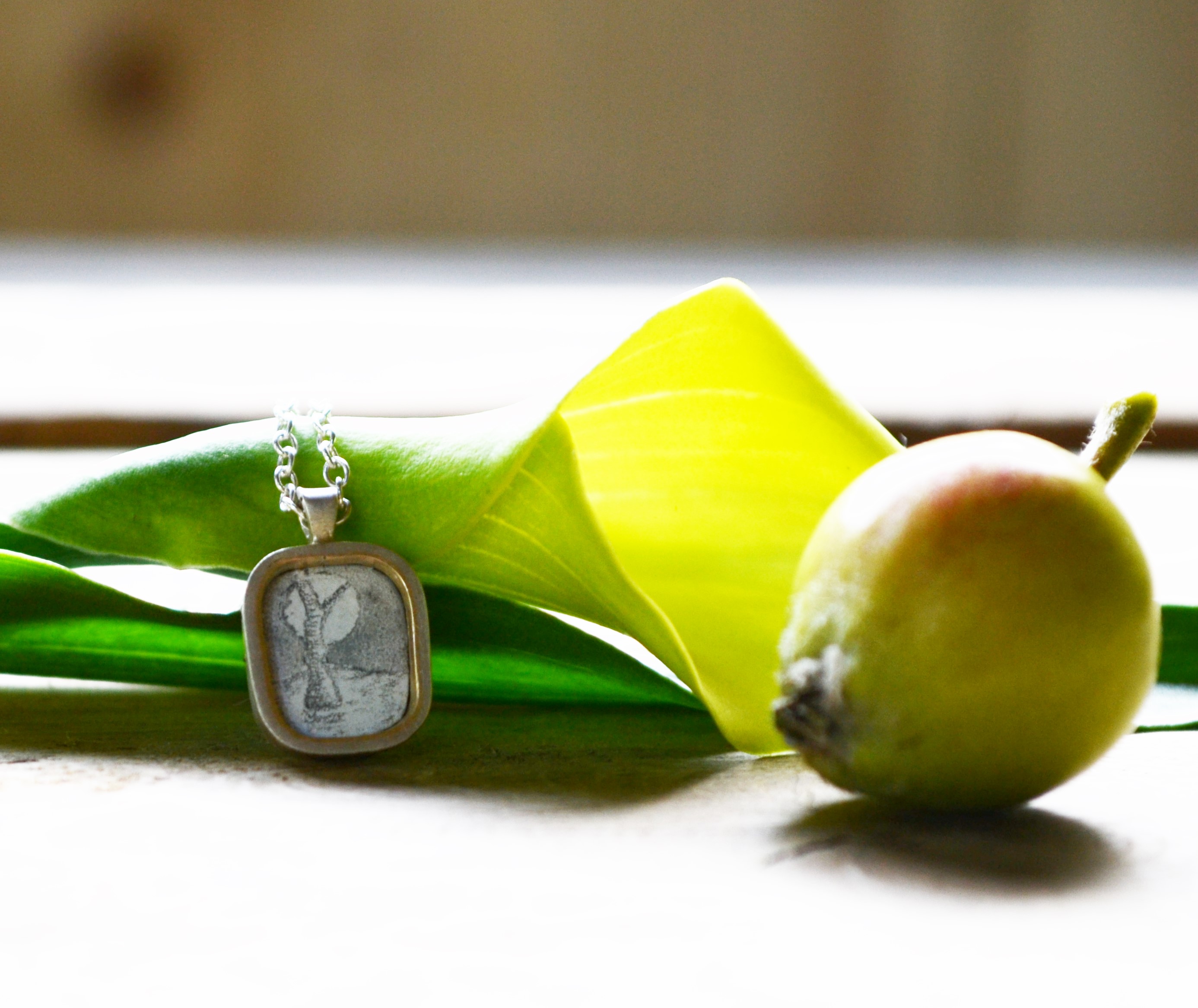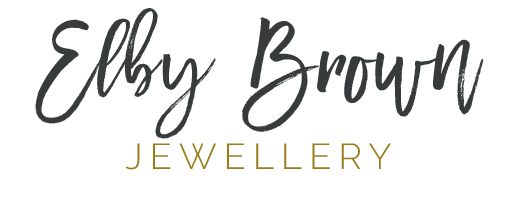What I love about hallmarking.
There is nothing better than getting a piece of jewellery back from the hallmarking office with the makers marks. Each stamp (or laser) on the precious metal tells a story (and I love a story). Here is an up close look at ‘my mark’ on the back of a recently returned piece.
 On you left can see LKB – my initials. Every maker has their own individual mark that leads like footprints right back to the maker. No two are the same and when you register with the hallmarking office you get to pick out your own from a selection. I really like, no, I love this mark. One day I am going to buy ‘my mark’, or maybe even have my own punch made so I can have it at home. (Yes that is possible and allowed but more on that later).
On you left can see LKB – my initials. Every maker has their own individual mark that leads like footprints right back to the maker. No two are the same and when you register with the hallmarking office you get to pick out your own from a selection. I really like, no, I love this mark. One day I am going to buy ‘my mark’, or maybe even have my own punch made so I can have it at home. (Yes that is possible and allowed but more on that later).
The next mark, a lion, shows that the piece is silver. The rule is whichever metal makes the most of the piece get the mark.
(Left to right – Silver, Britannia silver, Gold, Palladium, Platinum)
Third from the left – 925 which tells you the metal content. Then the mark of of the Assay office – I use Goldsmiths in London so the mark is a Leopard (each office is independent and has their own symbol). Finally, just one letter which conveys a lot. The year. The font, case and shape all change on January the 1st, no two are the same. So it really is a marker of the passage of time, a bookmark in the pages of makes in a lifetime.

These are good
The people who work at the London office – lovely, amazing helpful. Always willing to check out things for you, to make that extra little bit of effort… More than once I have had to phone and ask for a package to be sent back asap and every single time the lovely folk who work at the office have obliged.
Okay so you thought this post was called something quite different. Clearly, there is quite a bit I do like about the assay… So what’s my problem? What is the trouble with hallmarking?
It’s not me, its you.
It is an old institution and as with all old infrastructures, change comes slowly. Contemporary jewellery uses all sorts of materials in work. I am not a trailblazer of materials, I don’t use anything that would be considered unusual but I have had a piece refuse to be marked. It’s a (to) long story but here a quick synopsis.
The piece in question contained copper. In itself copper can be marked as such with the sign ‘+metal’. However, the piece I had made meant the copper edges weren’t visible to the consumer because I had set it in a frame and even though I stated the piece contained copper (and also stated it in my selling description) the office would not mark it as the extent of the copper could not be seen. To my head this made no sense – okay you couldn’t see the copper but surely you can see the extent of it. The piece is only 9mm deep, and 1cm across. The copper is no more than that.
I trust you.
The hallmarking office works on a basis of trust – you don’t have to send pieces finished you just have to send the component parts and the office trust that what they see is what the maker will put in the actual piece. Most (organised) jewellers send unfinished pieces or some barely started pieces. They would not trust however that I was telling them copper was in there and it was approx 7mm deep and 8mm across, nor would they mark if I had sent the pieces separately because then the edges would still not be visible.
Legally, I wasn’t allowed to say the piece was made of silver or gold (or was I? The rules are fuzzy about this one as it had been to hallmarking so had been tested positive for these metals). And what did it say about the value of my work?
Below right is the original piece.
All that is precious
 The ongoing discussion I raised with the hallmarking office changed my design. I now use fine silver or sterling silver to enamel if I want to set a piece like this shown right (which can be a pain for many reasons but I can live with it as it).
The ongoing discussion I raised with the hallmarking office changed my design. I now use fine silver or sterling silver to enamel if I want to set a piece like this shown right (which can be a pain for many reasons but I can live with it as it).
Luckily the piece I made went to another jewellery maker who knew its value and didn’t mind one bit that it wasn’t hallmarked.
For some makers though this rule has fundamentally changed the actual aesthetic of their design. Copper is not only one of the easiest of materials to enamel and it is durable but also it reacts differently with enamel. (Science innit!). It irks me that this happens.
Stick to the rules
It is not illegal not to hallmark, in fact if the piece weighs under eight grams you don’t have to. I do mark some pieces and others I don’t, depending on weight.
I know makers who make the most beautiful jewellery, their style so strong you instantly recognise their work. They don’t hallmark pieces.
However, If you don’t hallmark jewellery over eight grams you can’t describe a piece as silver or gold. You are instead supposed to refer to it as “white metal” or “yellow metal” or risk a complaint to trading standards. After that I am not sure what, if anything happens, especially is the piece IS made of precious metals.
Originally, I thought the Assay was to ensure a piece could be traced, to describe what was in a piece to a consumer, to tell a story with meaning. Actually in reply to a message I sent from a member of the assay it’s actual role is in place “to eliminate fraudulent sale of precious metal.” This is the Hallmarking Act in a very, very small nutshell.
Slightly less romantic than my take on things. I actually think that the assay describing its role in such a way it is devaluing itself. Also does it prevent fraud? Anyone can buy a 925 stamp – google it. And I am pretty sure that it doesn’t prevent fraud.
The value of things
And what of value? What does it mean if a piece of precious jewellery or art isn’t marked? Well, here is a quote from an Independent article from 1996 click here to read the full piece.
But what of contemporary silversmiths in this country? Some of those at the cutting edge of silver design do not give a jot for hallmarking. What is the relevance to silver design, they ask scornfully, of a system devised by Edward I in 1300 to make sure that silver plate turned into coin was of the same sterling standard?
Alistair McCallum, a 51-year-old Australian silversmith working in this country, says: “The only good reason for hallmarking a piece of silver is if it has no artistic value, only bullion value”.
His bowls, by the Japanese mokume gane or “wood-grain” process, so-called because of its flecks of silver mixed with copper, cost about pounds 2,000 each. The mixture of metals disqualifies them from hallmarking as silver. Even the silver rim of one of them was rejected by the London assay office on the grounds that it was attached to mixed metal. So he no longer bothers with hallmarking. That means he cannot legally call his work silver. But so what? “People who buy my work are aware of its value – and that is not determined just by weighing it”.
McCallum’s bowls are not the only contemporary silverware that seem to be retreating ever farther beyond the pale of the assay office. Who would have guessed that the red wire trumpet by another Australian, 48-year- old Robert Baines, was silver at all? In fact it is silver wire lacquered red. To hallmark it would be to knock a hole in it.
You can compare displays of silverware commissioned by Goldsmiths Hall – every one hallmarked – with those commissioned by the V&A, which include Baines’s unhallmarked trumpet, McCallum’s unhallmarked bowls and some delightfully straggly unhallmarked necklaces of oxidised silver that look like barbed wire, by the 40-year-old Briton Cynthia Cousens.
“The point of this gallery,” says its curator, Philippa Glanville, “is to see how conservative, or otherwise, the Brits are. We don’t take sides on hallmarking.”
Its not (just) you, It’s me (too)
This hallmarking business means that my pieces takes longer to get out to buyers. It adds an extra week, at least. It costs more to hallmark one piece and so it is not really at all economical.The best thing to do is to send a batch and for me making a batch takes time. This admittedly is my fault… I need to be more organised. I think I have a system from now on, which is fine. It needed to happen but that said I am not factory.
I thought for a long while about hallmarking and talked to other makers too. As I have said I love the makers’ mark and I like to see it on my work. I am going to buy my own punch. That is the dream (I don’t get out much).
So enough about trouble, solutions?
What if…. I still had to register with the Assay. I received a set of punches denoting my mark and materials. When I made each piece I stamped it and had to log it with the assay with pictures and a brief description of materials or process if the material was not entirely visible (perhaps if I used other materials a ‘+metal’ or ‘+wool’ or ‘+resin’ punch could be added). All visible to the public. This is not much different to what I have to do in my online shop anyhow.
If a consumer had an issue they could check and if they had doubts they could send off the piece for traditional tests and if it was not made of the materials described then the maker is somehow fined and it is marked on the record. If the hallmarking office depends on trust anyhow this surely isn’t any different. It means less traveling, less cost, less time, more ownership.
I would love to know what you think about hallmarking and what it means to you. Good, bad or indifferent? Any better ideas? Let me know.


Kelly Archer
That was really interesting. Especially when you mentioned the enamelled piece on copper that was set in gold. Food for thought…..but I have a secret lust to get my own hallmark too! I think for me it’s to say ‘I made that!’ and for future generations to look back and recognise my work. X
elbyjewellery
Hi Kelly,
It’s a pain for sure as I think the most resilient thing to enamel on is copper really, especially with opaque enamels and cost wise too. You’re fine if the copper shows somewhere! The hallmarking office have always been super helpful but outdated methods/ideas.
I would love to have my own initial punch here at home. (I will probably at some point!) x